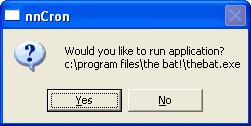
Starting Applications and Opening Documents
Options for Running Applications and Opening Documents:
START-APP: <command until the end of line>
Starts an application and proceeds to the next line of current task without waiting for the application to be closed.
Arguments of word START-APP: may include path to the desired program or document, name of the executable file and all required command line parameters. If the argument contains a name of a document rather than that of an executable file, nnCron will open this document in a program which is the registered program for files of this type.
Examples:
#( test_start_app \ starting Internet Explorer on every week day at 10:00 A.M. Time: 0 10 * * 1-5 * Action: START-APP: C:\Program Files\Internet Explorer\iexplore.exe \ after Internet Explorer has been started, nnCron proceeds to \execute the remainder of the task )#
#( test_start_app1 \ starting backup copying on Mondays and Thursdays at 2:30 A.M. Time: 30 2 * * 1,4 * Action: START-APP: nnbackup.exe sync -i d:\fido -o g:\backup\fido -s -v -e -da )#
There also exists a postfix version of this word:
S" app_name" START-APP
Attention, please: you cannot use the postfix word START-APP in console. To start an application from console use the word StartApp ( si a u -- ?):
0 S" app_name" StartApp DROP
See also "Options for Running Applications and Opening Documents", PROC-WAIT-IDLE.
START-APPW: <command to the end of line>
This word works similarly to START-APP:, but after starting an application it awaits for its completion, i.e. the next line in the task will be executed only after the application has been stopped.
Example:
#( test_start_appw \ starting Internet Explorer on every week day at 10:00 A.M. Time: 0 10 * * 1-5 * Action: START-APPW: C:\Program Files\Internet Explorer\iexplore.exe \ the remainder of task will not be executed \ until Internet Explorer window is closed by the user )#
Word START-APPW: permits to access the errorlevel code returned by the program which it started. The errorlevel number is stored in variable ExitCodeProc.
Example:
\ display a message if errorlevel number is not equal to zero START-APPW: xxx.exe ExitCodeProc 0 <> IF MSG: "Error %ExitCodeProc%!" THEN
Besides the standard set of options running applications, you can use option WaitFor: <ms or hh:mm> before START-APPW:; this option will terminate the application if it has not completed its work during specified period of time.
There also exists a postfix version of this word:
S" app_name" START-APPW
Attention, please: you cannot use the postfix word START-APPW in console. To start an application from console use the word StartAppWait ( si a u -- ?):
0 S" app_name" StartAppWait DROP
See also "Options for Running Applications and Opening Documents".
QSTART-APP: <command to the end of line>
This word works similarly to START-APP:, but before starting an application, it will display a dialog box asking: "Would you like to run application?". The application will be started only if the user selects Yes.

Example:
#( test_start_app
\ every week day at 5:30 P.M., asking user's permission
\ to start Internet Explorer
Time: 30 17 * * 1-5 *
Action:
QSTART-APP: C:\Program Files\Internet Explorer\iexplore.exe
)#
See also "Options for Running Applications and Opening Documents", PROC-WAIT-IDLE, QueryStartTimeout:, QueryStartAnswer:.
Options for Running Applications and Opening Documents
There are certain options for running applications and opening documents which can be used with words START-APP:, START-APPW: è QSTART-APP:; these options determine how applications will be started and how documents will be opened. Options should be separated by a blank space, a tabulation symbol or a newline symbol. They are placed before words which they modify.
| StartIn: "dir_path" | Sets the directory in which the application will be started. |
| ShowNormal SWHide ShowMaximized ShowMinimized ShowNoActivate |
Options for displaying application window:
|
| StartPos: <x> <y> | Specifies the absolute position of a window (in pixels) |
| StartSize: <xsize> <ysize> | Specifies window size (in pixels) |
| HighPriority IdlePriority NormalPriority RealtimePriority AboveNormalPriority BelowNormalPriority |
Sets a process's priority. Works only in WinNT/2000/XP, and words AboveNormalPriority and BelowNormalPriority - only in Win2000/XP. |
| AsService |
Starts an application as a service. This means that the program started in this way will not be terminated on user log-off. Option AsService permits nnCron to perform functions of utility SRVANY.EXE fromWinNT Res. Kit. Works only in WinNT/2000/XP. |
| Title: "console_title" | Sets a console window's title immediately on the application's startup. Works only with console windows.. |
| WaitFor: <ms> |
Terminates an application if it has not completed its work or been closed by a user during a specified period of time. Works only with word START-APPW:. |
Example:
#( backup_fido_and_tools
\ NoActive
Time: 30 2 * * 1,4 *
Action:
StartIn: "\tools\nnbackup"
ShowMinimized NormalPriority
START-APPW: nnbackup.exe sync -i d:\fido -o g:\backup\fido -s -v -e DA
LOG: "log\nncron.log" " > Exit Code: %ExitCodeProc% > FIDO backup"
StartIn: "\tools\nnbackup"
ShowMinimized NormalPriority
START-APPW: nnbackup.exe sync -i d:\tools -o g:\backup\tools -s -v -e DA -x *.lck
LOG: "log\nncron.log" " > Exit Code: %ExitCodeProc% > Tools backup"
)#
![]()